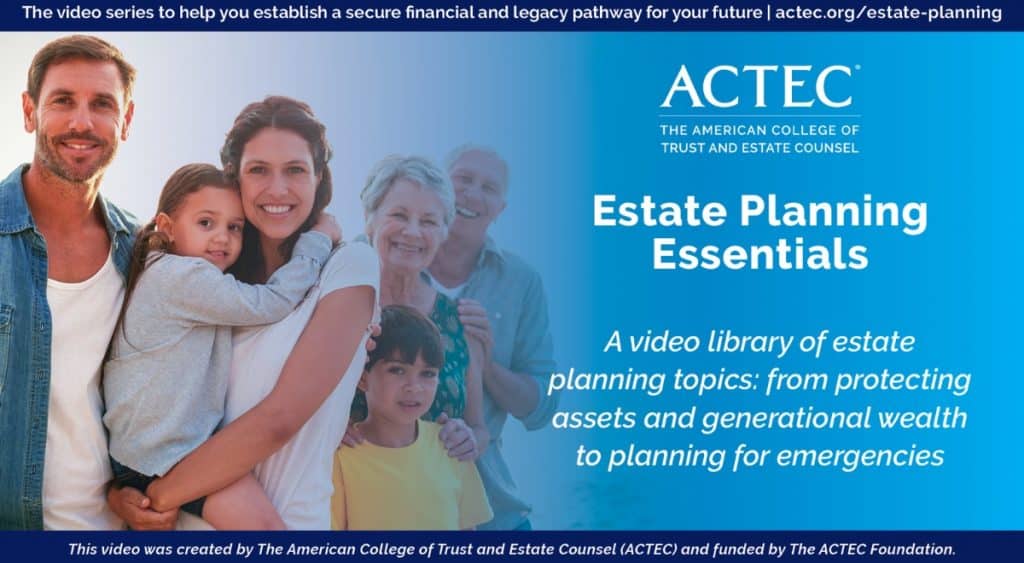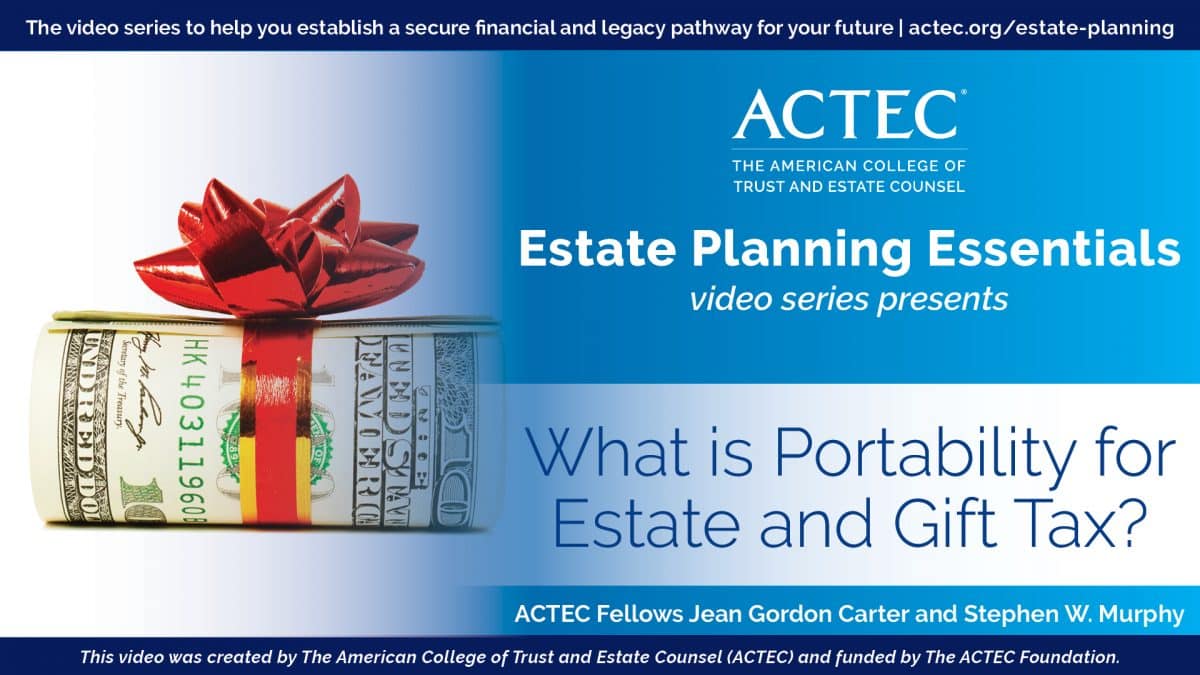Postmortem planning, often referred to as estate or legacy planning, involves managing and distributing a deceased person’s assets and affairs per their wishes and legal requirements. This includes settling debts, distributing inheritances, and addressing any tax implications arising after their death.
ACTEC Fellows Laura Beck and Jonathan (JP) Lee concisely summarize estate tax planning, disclaiming, decanting, portability options and the impact of pre-mortem decisions on postmortem planning.
Resources
Transcript
Hi. I’m JP Lee. I’m an ACTEC Fellow in Columbia, South Carolina, and my colleague Laura Beck is an ACTEC Fellow in Greenwich, Connecticut, and our topic is “Postmortem Planning.” Laura, when I say postmortem planning, what exactly do I mean by that?
Well, JP, as its name suggests, postmortem planning is planning that’s done after death. Usually, it involves making decisions that optimize tax elections or change or optimize how assets pass in order to enhance and make the estate plan as efficient as possible. But I think postmortem planning is a bit of a misnomer because although it happens after death, some of the best postmortem planning is actually done before someone dies in the sense that, when an estate plan is created, contemplating that some of this post-death decision-making will be made, and builds in enough flexibility and contemplates what decisions might happen, and what elections might be made. You have a much more flexible and dynamic plan, and much great ability for postmortem planning to have great effect and be very powerful. So, it’s a little bit of a misnomer, but when we talk about postmortem planning, we essentially mean decisions and elections that are made after someone dies to implement their estate plan effectively.
And it probably involves several different types of taxes. Tell me which taxes we’re talking about here.
Estate Tax and Income Tax Decisions
Yes. A lot of times, postmortem planning is looking at different elections and decisions that can be made. There are two basic categories of taxes that estates deal with: one is the estate tax itself or sometimes called the death tax, and the other are income taxes, both the decedent’s final income tax returns and also the estate’s income tax returns, because the estate is its own income taxpayer during the estate administration. So, there are a number of decisions that an executor needs to make both on the final return for the decedent and on the estate’s ongoing income tax returns– things like what fiscal year to use, whether to accelerate income, whether a trust is going to be a part of the estate plan, and whether it should share the estate’s income tax return or be a separate entity, and also whether some deduction should be taken on the estate’s income tax return, and whether those deductions can be better used on the estate’s death tax return. JP, do you want to talk a little bit about the death tax returns and some of the decisions that can be made there for postmortem planning?
Sure. I’m going to limit it to the federal estate tax return because in South Carolina, we do not have a state death tax. I know some states do, including Connecticut. But the federal estate tax return is based on the fair market value of the decedent’s assets as of the decedent’s date of death. But there’s an election called an alternate valuation that we can use that if the value of the assets went down six months after death and reduces the estate tax, we can use that alternate valuation date. That’s a planning technique to reduce the overall death tax payable.
One other tool is called portability. Every decedent, every person domiciled in the United States has an exemption from estate taxes. And if the decedent does not use that and has a surviving spouse, the surviving spouse can use the unused exemption amount. It’s called portability. It’s not perfect. It’s only applicable to the estate tax, not to the generation-skipping tax. So, if we wanted to do some dynasty trust planning, it’s not a perfect solution for that. But nevertheless, portability is a nice tool for federal tax planning. That’s really not that applicable for many states that have a state estate tax.
Another planning technique is to plan for the marital deduction. While everybody has an exemption, there’s also an amount that can be passed to a spouse in a tax qualified manner, and we can do certain things like disclaimers or make certain elections to make sure that the right amount goes to the spouse to qualify for that marital deduction. And I used the term disclaimer. So, tell me what a disclaimer is, and when you might use it, and what might be some of the requirements.
Disclaimer
A disclaimer is essentially a decision by a beneficiary to refuse to accept assets or property that otherwise were being left to them by a decedent. So, a beneficiary can say, a particular asset or a portion of the assets in total that are being left to me, I’m going to refuse to accept or disclaim. And if that disclaimer is made within nine months of the decedent’s death and if certain technical requirements are followed, then the assets can pass under the estate plan as if that beneficiary had actually died before the decedent who left them the assets. So, if the plan calls for leaving assets to one person, but there is a tax or other benefit in the family’s mind to having another person receive those assets and if the plan is properly contemplated, if one person dies before or disclaims assets, they will go to another person and that matches what the family wants, then there is a way to kind of alter or change the flow of assets without any negative tax consequences and sometimes with some good tax benefits by using disclaimers. I will say it is one of the good ways of changing an estate plan for tax or other purposes, but it’s not the only way and it has its limitations because it does have this time limitation on it and some other technical requirements. There are some other ways, though to modify the flow of assets over time from a trust or an estate like modification and some other tools. JP, do you want to talk about things that are available besides disclaimers?
Sure. Sometimes we have trusts that are set up that just for whatever reason don’t work in the situation. And we can modify those trusts, sometimes administratively or dispositively. Administratively, many states have what are called non-judicial settlement agreements that we for instance, might be able to change the trustee, or the trustee succession, or the governing law of the trust. And we might have other ways to change the dispositive provisions. Sometimes those dispositive provision changes require consent. Sometimes they require judicial approval, and sometimes they can be done by what’s called decanting. For the wine drinkers out there, decanting is what it sounds like, which is leaving the undesirable characteristics of trust one behind and passing them to trust two with more favorable characteristics. But there are certain requirements that have to be met and the really threshold question is how much does vessel number two, or trust number two, have to look like trust number one. I think probably postmortem planning could probably succinctly be summarized as it offers some tools, perhaps not perfect, but widely expanded if the pre-death planning contemplates the post-death planning options. Is that a fair statement?
I agree. I think to a certain extent, the best postmortem planning is postmortem planning that was done pre-mortem.
Perfect. Laura, this has been a lot of fun. Thanks for your time.
Thank you, JP.
Featured Video
What is Portability for Estate and Gift Tax?
An explanation of the portability of the estate and gift tax exemption and what to consider if electing to use it.
ACTEC Estate Planning Essentials

ACTEC Fellows provide answers to frequently asked trust and estate planning questions in this video series.



